How Natural Systems Work… is by forming processes that produce a profit, used to grow it, in a burst of creative self-organization, to become sustainable ONLY IF the profits that built it get used to maintain what was built; the essential road map.
That general model of nature’s “facts of life” is your “quick start”. Following is a foreword and then a compact introduction to a scientific method. Anyone can observe the details of how developmental systems work by just learning to study the development of individual systems in nature. You start with learning how to identify natural “living systems” as what fills our environments from watching how they develop. Then you can recognize them as cells of organization that produce resources for their own development. Easier reading descriptions are found in:
“In a Nut Shell“ and Why ?¸¸.·´ ¯ `·.¸¸ The scientific method
How Natural Systems Fail… A growth system that can’t change to maintaining itself after building itself, becomes disabled. As for our modern world economy, at the limits of the earth, keeps devoting more and more effort to expanding, it drains resources from maintaining itself. What’s wrong is the essential road map for sustainability is missing. It is absent from our great cultural conversations, absent from the models of the professions and groups trying to stabilize the economy or seek “sustainability”.
_______________________________________________
An Organizational Stages Model (OSM)
– the science –
Foreword: Understanding natural systems involves learning how to first recognize them as individually developing systems, and then discover some of the hidden organization within them. You can find them where you see events have “lives of their own”. The real learning is a “learning by doing” process, as the key is discovering how to define your words by referring to self-defining objects of the natural world, not defining words with other words or use abstract models.
Abstract languages are “self-referential” and what a science of natural systems needs is words defined by nature. To understand system models, then, you then need to consider them as questions about the real world subjects that are NOT in the model… but referred to by the words associated with the natural subject, a new way of scientific thinking.
Most any history of events will have periods of accumulating change that speed up and then slow down. That becomes the main subject, the key that unlocks the basket of productive questions about “what’s happening”. It’s the question that identifies a systematic process of change as a sign of a developmental process and evidence of a self-organizing system doing it.
When some local system of change is “taking off” or later “fading away”, you notice where it and begin piecing together what is doing it, by watching for regularly changing rates of change. It could be anything from the history of your own career choices, to the stages of organization for “the big prom”, the founding of your own business or the dramatic global shifts in economies and societies that “history” is itself a record of.
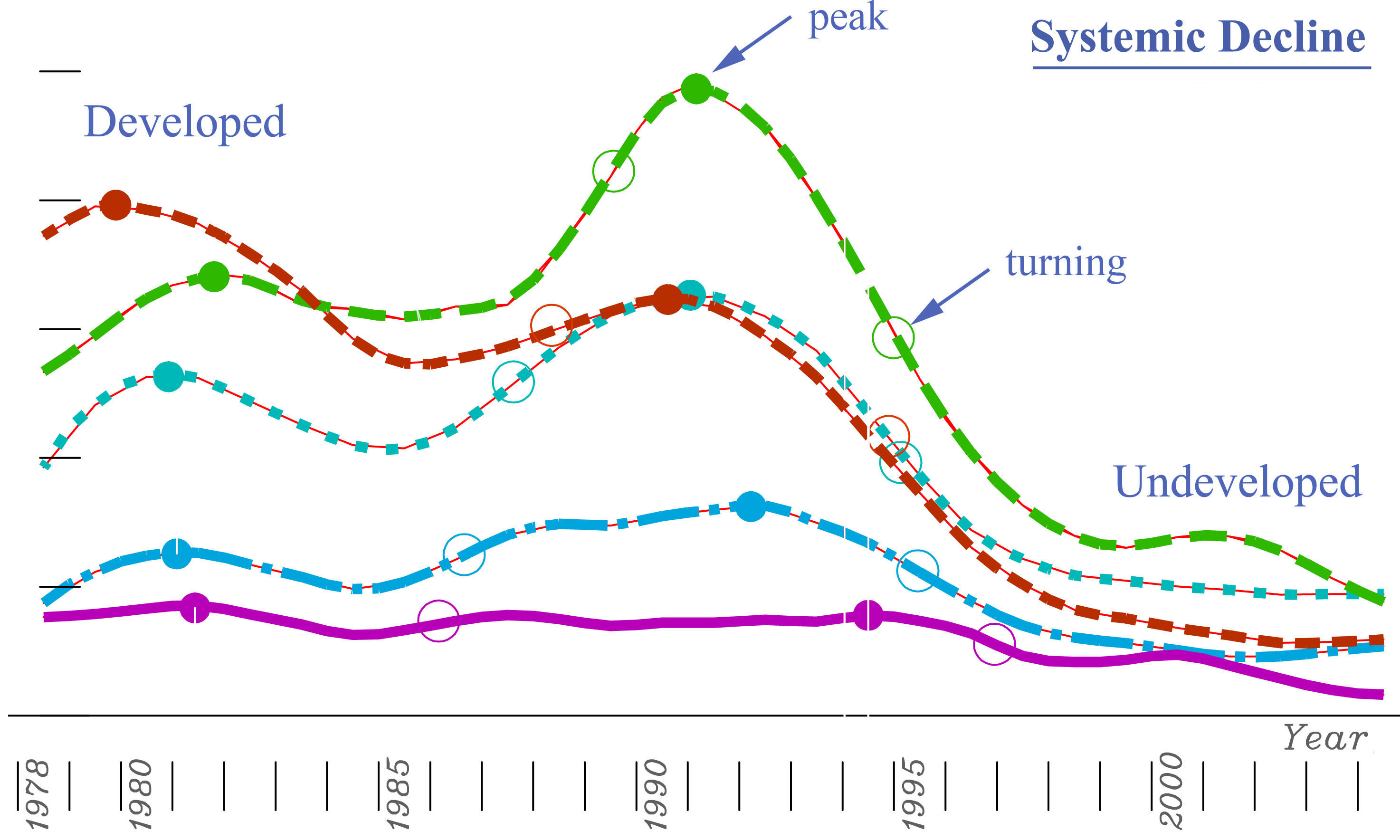
[This is a sample graph showing a real systemic transformation. Only the data is shown to focus your attention on the changing rates of change](i)
It definitely helps to have some kind of “data” to indicate when locally developing changes are speeding up or slowing down, and notice the turning point from one to the other. The different periods of behavior display different states of organization, and are used for “building a narrative ” for how one transitions into the next. The traditional scientific. For systems with hidden organization, it’s the continuity of change that is the direct evidence, of organization you can’t actually see, but can expect to find if you look there for it.
Making notes on everything involved helps you make confirmable guesses about the continuous chains of events, as you think about your observations like a detective. For example an indicator might suggest the turning point from faster to slower change was at one time. The details might showing it really occurred earlier or later, possibly changing the whole story, as in the case of the event depicted above (i).
Notes on the continuities of change help you string together the dynamic flowing way nature “connects the dots”. If your observations contain assumptions they won’t fit the flows of change as well, so being completely innocent and honest in making observations, free of other thought, is a key to developing good guesses to later confirm about what is actually happening. For busy minds that’s hard!. In my own thinking I find some of my assumptions can be pealed away, by exaggerating them not fighting them. They become just ridiculous, which lets me have some fun and also more able to separate the subjective story from the real observation, making both more clear.
Any ideas or suggestions are quite welcome.
– references –
Some of my older introductions are listed below as “Other General Introductions”. You may find one of interest, or prefer to browse my extensive collection of other short discussions here on the blog. I’m particularly proud of The “3Step approach to working with nature” as a great tool for getting work groups to actively explore their environments to find anything that achieving their ideals might need to work with. Actively exploring ones environment without any intended plan for it or preconceptions of what it there is tremendously important to learn to get good at this. The principle is you can find anything you need to know is connected to what you truly care about.
i) The data in Fig. A is from a study of the mysterious collapse in NYC murder ratesthat started abruptly at the very peak of the crack epidemic in 1990, and lead to a lasting period when people stopped being afraid to live and play in New York.
– That there even was a major citywide culture change did not get into the papers, though the signs of it were simply everywhere, as it “had no name”. The only real reporting on it was on various relatively small political or policing policy changes taking credit for the very unexpected regular citywide declines in violence.
– The five curves show the murder rates of the five boroughs, smoothed by a mathematical method that does not lose the dynamics of the underlying process, called “derivative reconstruction”. Giuliani was elected at about the “turning point” when the initial accelerating declines in the murder rate started to slow down…
ed: 7/18/13
________________
Natural Systems Science – “Quick Start”
I. A Temporal Map – a life-cycle as a individual wholeevent in time
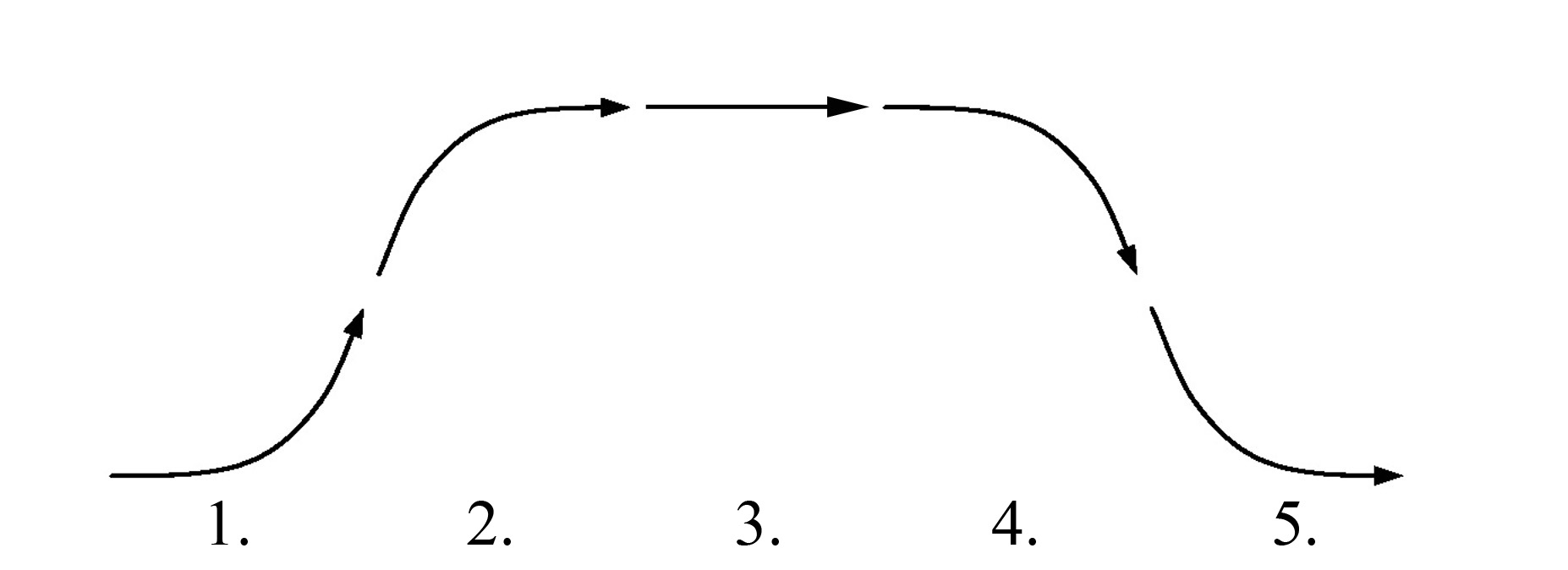
The idea is that natural systems have a developmental life-cycle, composed of periods continuous accumulative change. If you trace the continuity of their changes with “whole system indicators” like ‘energy use’, ‘scale’ or even ‘performance’, or many other ways, the shapes in the curves help you see distinct periods of progressive change (symbolized as 1, 2, 4, 5 above) that mark the irreversible changes (being simply accumulative) in how the system works over its life cycle. Associating those periods with narratives for what is observed happening, lets one identify what is becoming more systematic as a whole system behavior. Systems that become [3] ‘sustained’ for some period need to have both periods of [1] ‘emergence’ and [2] ‘integration’, and ‘endings’ that include both periods of [4] ‘disintegration’ and [5] ‘decay’, with the kind of progressive change you see usually indicating “where it is” in its life cycle (its place in time).
II. A Spatial Map – a system that operates itself
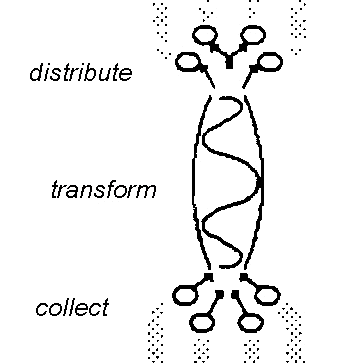
Progressive change occurring within a boundary indicates locally occurring self-organizing processes, evidence of “a local system” with a ‘life of its own’ emerging as an individual. To emerge and work locally as a system it needs its own form of organization, independent of others, not independence from other influences but of its organization of working parts, and by that organization having evolved where it is seen working.
Noticing what else besides its key indicators is changing along with it helps define its location and the shape of its self-defining boundary, as“where it is” in the environment (its place in space). That helps distinguish between its interior and exterior relationships as an individual whole system, and to begin asking about the organization of its interior working parts, how they developed, and how they rely on their external relationships. These all follow from observing locally independent progressive change.
III. A Cognitive Map – for nature to theory and back
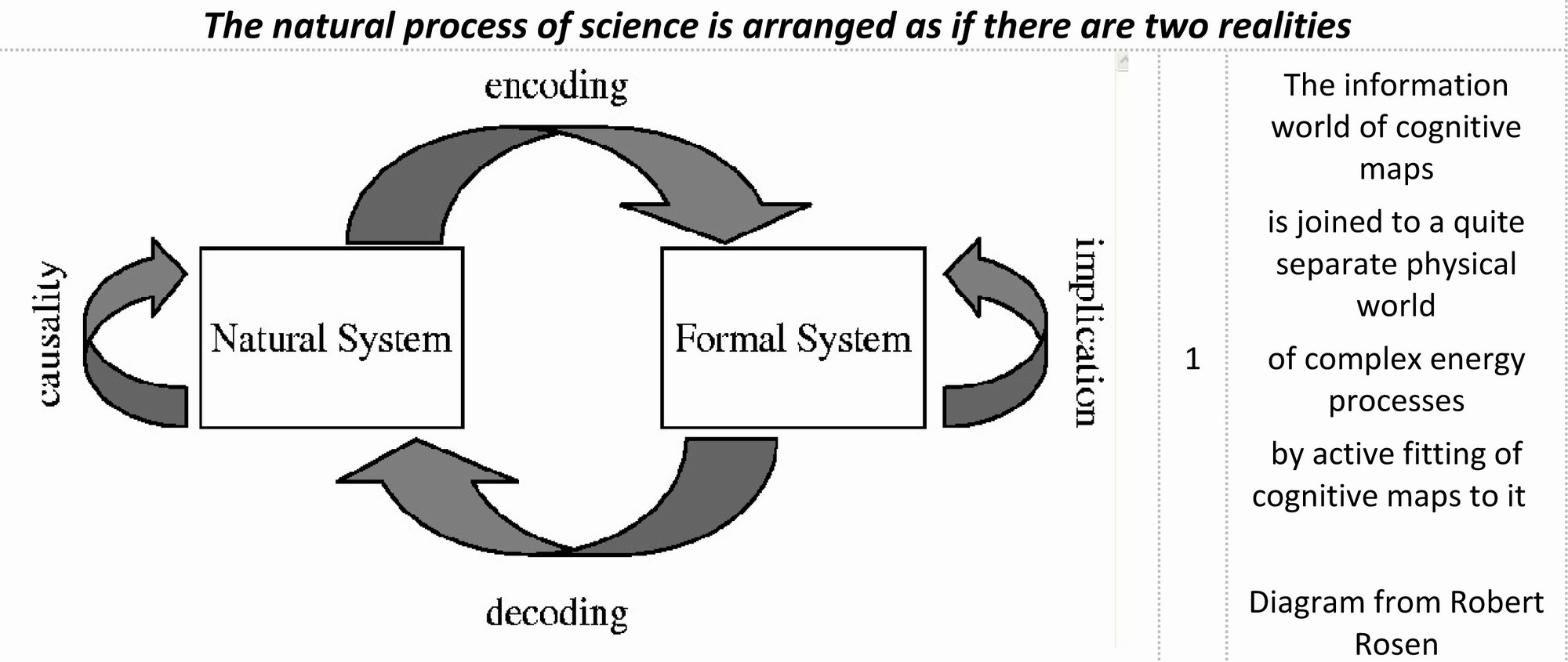
So “what is it” and “where is it headed” are the kinds of questions to ask, as you begin “building a case”, moving your attention back and forth between the Natural System (what’s being observed) & the Formal System (what’s being imagined), using both theory & intuition to generate and narrow down hypotheses as way to build up a mental map of the far more complex local working parts of the natural world.
IV. An Information Record Map – everything by how it connects
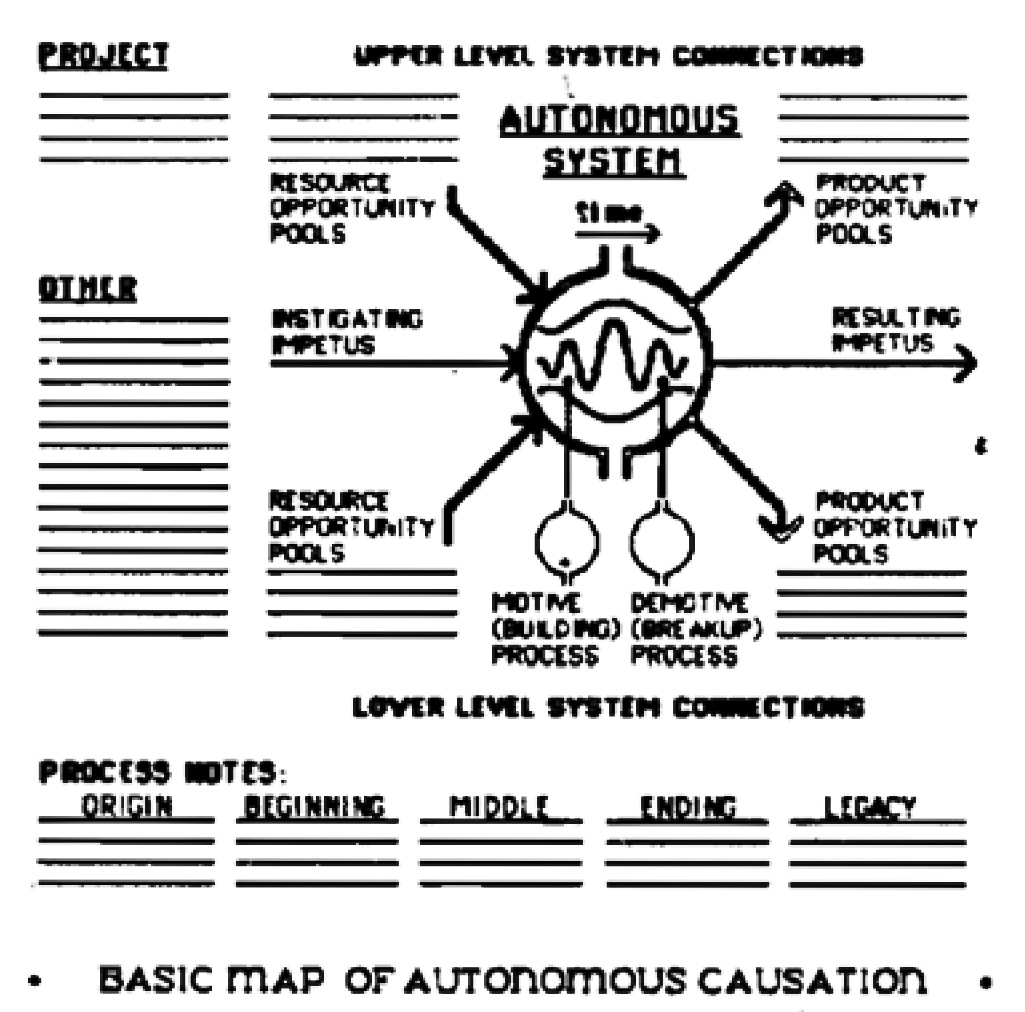
You’ll need places for taking notes, to record observations on the system and its place in its various environments, to help identify and verify some of its internal and external relationships, creating a complex story for it, that others can use to locate what you are talking about in the natural world and to add to or edit the story based on new perspectives, on what has, is or will be happening, as how the system and its environments keep changing.
jlh
______________
Other general introductions to the natural systems science method:
1. 70’s to 00’s In the Synapse9 archive Physics for Natural Open Systems
a. Bump on a Curve ¸¸.·´ ¯ `·.¸¸ Notepad For Dummies
c. Physics of Happening… the studies demonstrating mathematical methods
of systems recognition
2. 2013 3Step process for Working With Nature and the Draft Facilitator’s Guide
3. sample of the recent in-depth blog posts on the general method
a. 2012 Steps to a natural systems view
b. 2012 Self-organization as “niche making”
c. 2012 Emotionally proofreading your logical models
4. 2011 Systems Energy Assessment – systems physics of whole systems, “how to measure them”
5. 2011 A decisive moment for Investing in Sustainability
6. 2011 The curious use of Stimulus for Constraint – systems physics of economies, “how to steer them”
7. 2010 Life’s Hidden Resources for Learning & 2008 Models Learning Change essays in Cosmos & History
8. 1995-2010 The Energy Physics of Continuity in Change why change begins with bursts of self-organization
9. 1995 Reconstructing the Physical Continuity of Events, math and methods for recognizing processes of developmental change
10. 1985 Directed Opportunity, Directed Impetus: New tools for investigating autonomous causation, conceptual study of causation
11. 1979 An Unhidden Pattern of Events implications of nature displaying both continuity and events
______________
